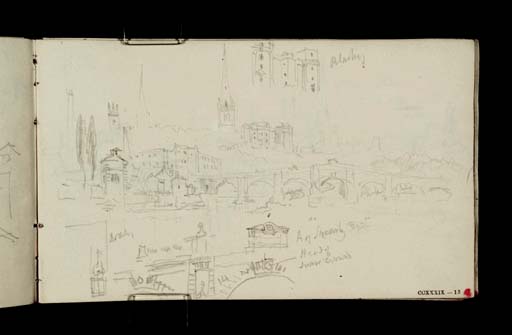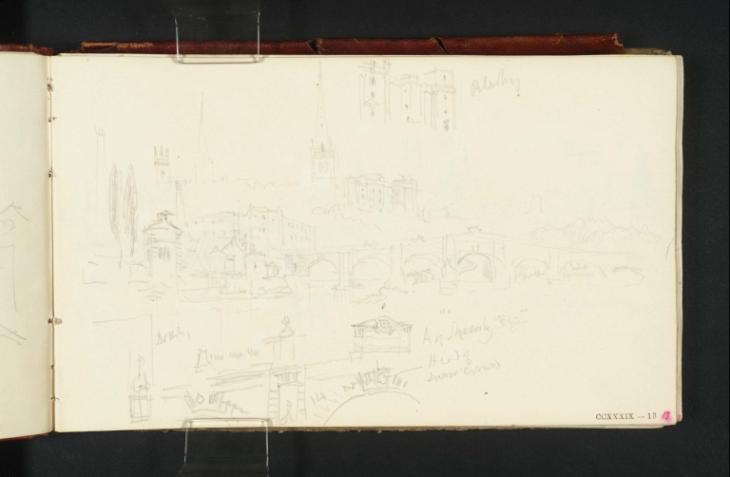Joseph Mallord William Turner Shrewsbury from the South-East, across the English Bridge over the River Severn, with Details of the Infirmary and Bridge ?1831
Image 1 of 2
-
 Joseph Mallord William Turner, Shrewsbury from the South-East, across the English Bridge over the River Severn, with Details of the Infirmary and Bridge ?1831
Joseph Mallord William Turner, Shrewsbury from the South-East, across the English Bridge over the River Severn, with Details of the Infirmary and Bridge ?1831 -
 Joseph Mallord William Turner, Shrewsbury from the South-East, across the English Bridge over the River Severn, with Details of the Infirmary and Bridge ?1831 (Enhanced image)Enhanced image
Joseph Mallord William Turner, Shrewsbury from the South-East, across the English Bridge over the River Severn, with Details of the Infirmary and Bridge ?1831 (Enhanced image)Enhanced image
Joseph Mallord William Turner,
Shrewsbury from the South-East, across the English Bridge over the River Severn, with Details of the Infirmary and Bridge
?1831
Joseph Mallord William Turner 1775–1851
Folio 13 Recto:
Shrewsbury from the South-East, across the English Bridge over the River Severn, with Details of the Infirmary and Bridge ?1831
D22173
Turner Bequest CCXXXIX 13
Turner Bequest CCXXXIX 13
Pencil on white wove paper, 114 x 191 mm
Inscribed by Turner ‘Pilasters’ top right, ‘Dolphins’ towards bottom left, and ‘A of Shrewsby | Head of | Severn crownd’ with line drawn to relevant point on bridge bottom centre
Inscribed by John Ruskin in red ink ‘13’ bottom right
Stamped in black ‘CCXXXIX – 13’ bottom right
Inscribed by Turner ‘Pilasters’ top right, ‘Dolphins’ towards bottom left, and ‘A of Shrewsby | Head of | Severn crownd’ with line drawn to relevant point on bridge bottom centre
Inscribed by John Ruskin in red ink ‘13’ bottom right
Stamped in black ‘CCXXXIX – 13’ bottom right
Accepted by the nation as part of the Turner Bequest 1856
References
1909
A.J. Finberg, A Complete Inventory of the Drawings of the Turner Bequest, London 1909, vol.II, p.734, CCXXXIX 13 (as ‘Do. do.;’ i.e. ditto; ‘Shrewsbury, with the English Bridge’, as for folio 12 verso (D22172), ‘also details of bridge.–“A. of Shrewsbury, Head of ... carved.”’).
There is a similar prospect of Shrewsbury on folio 12 verso opposite (D22172), under which other views are discussed. Here Turner has moved slightly south-west along the east bank of the River Severn, showing the head-on aspect of the seven-arched English Bridge, built in 1768–74 by local architect John Gwynne, and widened in 1926.1 He has also drawn a detail of the classical central arch with its pediment (and the arch to its left) below, annotating the carved head on the central keystone. In an undated manuscript note, Finberg (died 1939) added ‘?Juno JPH’ as a reading of the penultimate word of Turner’s inscription, apparently citing the etcher and collector John Postle Heseltine (1843–1929),2 although rather than the Roman goddess the word seems to indicate ‘Severn’ followed by ‘crownd’, as a personification of the river. At the bottom left is a detail of one of the dolphins carved tail-up on the piers.
In the distance of the main view are the tower of St Julian’s Church (now St Julian’s Centre), and the spires of St Alkmund’s Church and St Mary the Virgin’s Church. To their right, and repeated in the sky above, is the Royal Salop Infirmary. This was noted as ‘the infirmary’ by Finberg and the watercolour and Turner scholar C.F. Bell (died 1966) in undated manuscript notes in copies of Finberg’s 1909 Inventory.3 Built between 1826 and 1830 in Greek Revival style by E.H. Haycock, it must have been conspicuous on the skyline when Turner recorded it here shortly afterwards; the hospital closed in the 1970s and now houses the Parade Shopping Centre.4
Matthew Imms
April 2014
A.J. Finberg, undated MS notes in a copy of Finberg 1909, Tate Britain Prints and Drawings Room, vol.II, on a blank interleaved page opposite p.734.
A.J. Finberg, undated MS notes in a copy of Finberg 1909, Tate Britain Prints and Drawings Room, vol.II, p.734; C.F. Bell, undated MS notes in another copy at the same location, vol.II, p.734.
See ‘The History: Royal Salop Infirmary’, The Parade Shopping Centre, accessed 26 September 2013, http://www.paradeshops.co.uk/The-History/p124/c39 .
How to cite
Matthew Imms, ‘Shrewsbury from the South-East, across the English Bridge over the River Severn, with Details of the Infirmary and Bridge ?1831 by Joseph Mallord William Turner’, catalogue entry, April 2014, in David Blayney Brown (ed.), J.M.W. Turner: Sketchbooks, Drawings and Watercolours, Tate Research Publication, September 2014, https://www

